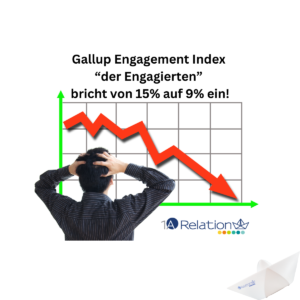After the selection comes the CRM system introduction
After selecting a suitable CRM system, the much more difficult phase now comes: the introduction or implementation of a new CRM system. Now the management must show its colours. There are a lot of things going on in a company: A CRM system introduction with all the trimmings costs a medium-sized company with 100 users quickly 750,000 euros for a period of 5 years. Depending on the amount of adjustment required, it can also quickly become 4 million euros. This is to be answered very individually. In any case, such an investment requires professional project management and steering committee control.
What are typical reader questions about CRM implementation?
- How to successfully introduce a software product?
- Why a CRM introduction at all? What are the reasons for a CRM implementation?
- How do you create enthusiasm and acceptance among the users?
- With which project management method is the introduction in the company carried out? Waterfall method with specifications or agile methods with unclear objectives
Those are the first four questions. All other questions, read in detail below.
Further questions:
7. How do you manage your project team and the service provider?
8. Customizing and additional programming
9. Test, check, test and the test phase before the roll-out
10. How does the data get cleanly into the CRM system? Import and Migration
11. connection of third party systems? Interfaces and Apis
12. What has to be considered for the roll-out? Stress test, final test, reworking
13. Why is the subject of education and training so important?
15. What are the reasons for the failure of the CRM implementation?
16. Communication of success – step by step
How to successfully introduce a software product to a customer?
This is a difficult question. This is what scholars, experts and practitioners argue about. There is no royal road. Although there’s always talk about it. Yes. He’s even promised. In theory, maybe it’s true. But in practice many things look different. We will now shed some light on this in the answers to the many questions.
One thing is important: The CRM strategy is not a project. Instead, a strategy pursues long-term objectives. These may, indeed must, be adapted in the course of an introduction. There are always new findings. And these can certainly lead to CRM strategy adjustments.
It is a misconception that the new CRM software only serves marketing, sales, and service. A successful CRM implementation is achieved when the CRM system has been networked into the entire company. Data and information is collected in the CRM solution and then decentralized to those who need this information. And this can also be the reception or the accounting department.
Why a CRM inmplementation at all? What are the reasons for a CRM implementation ?
There are several reasons. The old ERP or CRM system is no longer developed by the manufacturer. The costs for the current CRM solution are getting out of hand. The usage is much too low. This means that the promised or expected benefit for the company cannot be realised. The possibilities of your CRM system are limited, or it is too powerful and inflexible.
Can’t you just buy/rent the CRM system off the shelf and just get started?
That would be nice. But the vast majority of products promise the customer standard software. But the so-called standard looks completely different with every provider. This is exactly why a selection process like the one we offer is important. Here we work out the differences. This shows how far away the respective standard is from your current and future processes. The winner is the company that comes closest to the specifications.
How do you create enthusiasm and acceptance for CRM among the users?
The users – here the key users – are involved from the very beginning. I.e. in the selection, in the decision, in the choice of the service provider, in the optimization of the processes, in the formulation of the software requirements.
Another factor for customer acceptance is the intuitive operation. This only becomes apparent in the course of use. An application that is presented excellently does not guarantee employee acceptance. Only when they themselves „voluntarily, more and more intensively“ deal with the product, the use, the data maintenance. In a nutshell: When the degree of utilization is over 50% of the rented/purchased modules. AND, if more than 75% of the employees who have a license use the product regularly.
<h2″>With which project management method is the CRM implementation in the company carried out?
What method do you choose for implementation? The Waterfall method with specifications or rather the agile methods that are very fashionable right now?
How do you define the waterfall method?
Waterfall method means …
How do you define the agile method?
Agile method there are several different ones. For example Scrum, Design Thinking…
Here, one could start with the sample example of a customer journey and successively optimize the processes along this customer journey. This is first and foremost an approach that focuses on the customer and his contact points. An agile method can be helpful for this.
We once had to accompany a web shopping project. The CRM implementation did not go very smoothly, so we were called in. After a short time it was clear: It was a mix of waterfall and scrum. In each case, the bad components of the respective method came together.
The first thing we did was to define a method that was simpler and easier to understand for all parties involved. Just because you have heard of Scrum does not mean that you are a Scrum Master.
Will the CRM system be introduced to all defined users or will it only be partially implemented for the time being?
This is also one of the important points. What are the approaches to this?
One usually introduces step by step. Only in what steps.
- All functions for all users
- All functions for a part of the users
- parts of the functions and processes for all users
- parts of the functions for a part of the users
Or first in one region, in one country, then come the others to introduce. Or one department first, then the other. There is not a single answer to this question except: It depends on how the customer can organize it. How well can the existing, remaining programs, IT solutions and processes be separated from the CRM solution? What does parallel operation mean for IT and users? This has to be considered and decided very individually.
If only 20% of the users are present at the start, then this is a possibility. In the first step, they put everything through its paces. only then do the colleagues follow.
Are all requirements clearly defined, is the contract clear and transparent? Or are there still expenses and costs to be clarified with the provider?
Very often the contract with the manufacturer as well as the service provider is not completely and sufficiently clearly formulated. As always, when you have a dispute, you find that out. Who pays for the additional costs? Was that a change request? Who is responsible for it? Isn’t that covered in the contract?
Therefore, after the basic decision for a manufacturer, we advise you to take enough time for contract negotiations. This always pays off in the course of time. And there doesn’t even have to be a fight about the money. It is already helpful if the contract serves as a guard rail for a good cooperation between manufacturer, service provider, hosting partner and possibly third party providers.
What is to be considered from the point of view of technology, software and hardware?
Technical topics for implementation are e.g. hosting (where?), cloud solution, what kind of cloud or own data center. Which third-party licenses are necessary and drive up costs? Who does the technical set-up: test installation and support of the live system (server landscape, firewall etc.)
And not to forget the bandwidth. How many MBit is the line from the data center? How much does the user receive?
How do you manage your project team and service provider(s)?
A CRM project is always a balancing act. As described above, a good treaty can already be a good guard rail. Nevertheless, the client needs a strong project manager. Maybe even two. Because right from the start, the course of the project is not life on a pony farm. Implementing a CRM solution quickly takes up 30% or 50% of an employee’s time.
Therefore, one of our most important demands before the start of the implementation is: Relieve your key employees. Stop, better finish the project work that is still running in parallel first. Delegate tasks to other employees. One criterion for success is that the project managers also have time for the tasks of a project manager. This is a part-time job. You can’t do this on the side.
On the one hand, you need a project management method, good and intensive communication, clearly defined project rules, clean documentation, deadlines defined in time (with the project team as well as with the steering committee)
Customizing and additional programming
If, as is often the case, the standard is not sufficient, the user demands adjustments to the CRM processes. This can be done through customizing. Or in the more complex, usually more elaborate case by additional programming? In any case, when choosing the right CRM system, you already have a very precise estimate of what additional programming could be added over the next 2 to 3 years. We clarify this with an Excel table containing all requirements in advance. The CRM provider must then provide a cost estimate for each point. It doesn’t have to be exact. But the estimation should be so accurate that it is clear whether it is 2 to 3 days, 5 to 7 days or 20 to 30 days effort.
Tip: Do you clarify in advance whether the additional programming increases the basis for the license price and thus the maintenance costs?
Are the requirements for customizing or additional programming clearly formulated? Customizing sounds from the mouth of a manufacturer, but no effort is required. There is indeed effort involved. If the client is aware of the fact that he needs customizing again and again, then it makes sense to get a team of 2 or 3 people fit so that they can do the customizing in the future. This saves money and nerves.
During the introduction of an ERP system, the managing director refused to have his own employees trained for customizing and additional programming. Unfortunately, after 2 1/2 years of project duration and 100% cost increase, he had to pay very dearly for this. He could have hired at least one person for this. Our own know-how pays off in the long term. In general, technology topics are becoming more and more important. Demand in IT is always more than decreasing.
testing, testing, testing and the test phase before the roll-out
Once the adjustments have been made by customizing or programming, it is time to test. The user writes a test protocol, documents what was good or less good. Then it goes into optimization. And if everything works, then the release will take place.
During the course of the CRM project, testing is carried out. But before the roll-out, testing is even more important. Individual tests, mass tests, stress tests… The best thing is to reserve a weekend, the employees are freed from the day’s work and can concentrate on comprehensive testing.
How does the data get cleanly into the CRM system? Import and migration
An evergreen hot topic within customer relationship management is the topic of address quality and data quality. In almost every project this effort is underestimated. This begins with the cleansing of the fields and addresses. This continues with field mapping. This is an enormous amount of time, for discussion and decision making. Which data is deleted, which is not transferred, but not deleted for the time being? What new data can be derived from the existing data? Is it possible to transfer the wrong field contents to the appropriate field? Can this be done automatically by program or only manually?
connection of third party systems? Interfaces and Apis
With every new CRM system, interfaces to other systems are created. Whether e-commerce, call center, document management system, content management system, e-mail marketing system …, the customer usually has a very colorful solution. Once again NO standard.
How do you connect these third-party systems or other, new systems? How deeply do the systems integrate with each other? Uni- or bi-directional? With REST, SOAP or ODBC interfaces. Is there a connection via paper. How often must the data exchange take place? In real time, every five minutes every hour, every night.
Possibly there are also apps in the App-Exchange-World of Salesforce, Microsoft, SAP or other manufacturers that support this topic.
What is to be observed during the roll-out? Load test, final test, reworking
Here comes in one week the suitable text.
Why is the topic of education and training so important for good CRM?
One must unlearn the old system, learn the new one. Therefore a detailed training, a training plan and a learning control are very important. In this way, all employees who are involved in the roll-out achieve their basic knowledge. Nobody wants to stand on these. So it needs a practice or training plan. You know this from musicians or sportsmen. even craftsmen practice with their tools before they use them at the customer’s site. And so is this. Only those who want to maintain and improve their level will remain successful. Therefore, continuous training is needed.
The training consists of process flow training, technical skills, training on customer orientation, attitude and attitude.
CRM vendors such as Salesforce, Microsoft or SAP, but also Cursor, CAS and other midsize providers offer an academy where the product can be trained.
avoidable mistakes: no investment in address and data quality, no change management, no changed management by new targets
If the software goes live and the address quality as well as the data quality is as bad as before, then unfortunately a false start is pre-programmed. Education and training are one thing. Customer orientation is a cultural issue. Goals and management tasks as well as methods are changing. A company does not change this from one day to the next.
To achieve this, top management must be on board from the very beginning, questioning themselves, adapting their own tasks and behaviour and changing their goals and leadership. Ultimately, this results in a modified formulation of the vision and corporate goals.
Tip:
It also requires a change in the organization. CRM, customer orientation, etc. require a new organisation geared to the target and customer groups. the old, functionally structured organisation no longer works. It is not enough to inspire sales or marketing. CRM intervenes in the whole company. This is not what a software introduction does.
What are the reasons for the failure of the CRM implementation?
In the context of a company development under the umbrella of a digital transformation, there are always a lot of projects running. The IT landscape is usually not only modernized, but revolutionized. Outdated technologies are replaced by new technologies. Interfaces are adapted or completely redesigned.
That means in plain language. If you juggle many balls (here projects), you run the risk of losing the ball (CRM tool does not work). What are the important reasons for failure? We have listed in section software application a lot of reasons. Therefore here are just a few reasons in extracts:
- Missing vision of the company, employees do not recognize any advantages
- Easily prescribed CRM software without the involvement of employees
- No role model function of managers in CRM system use
- Missing data and address quality in the CRM system
In the meantime we have collected more than 20 reasons. Not all of them occur simultaneously in a company. But 3-5 reasons usually are. Identifying and eradicating these is usually the greater effort afterwards. Therefore, knowing the possible pitfalls and obstacles, we make sure in advance that these do not even occur.
Communication of successes – marketing for the course of the project – step by step
Communication via the CRM software within the course of the project is extremely important. For many in the company CRM is a strategic topic. It puts a lot of stock in it. If rumors arise on the topic of CRM because too little or wrong communication is being done, this is very damaging. Therefore a continuous communication about the new software, changed CRM processes, status quo of the installation etc. is very important.
This can be in the canteen as a display, flyer or video. Podcasts and experiences of key users can be heard on the intranet. The CRM provider creates a video from screenshots. A video shoulder view shows what has happened. The management is available for questions and answers in the topic chat. Only the management is not allowed to hide behind the chat, but also to be seen in the hallway at „Management by wandering around“ and to advertise projects. There are many ideas how to communicate the milestone or completion of a subproject.
The main thing is to do it. Continuous information is very important for the uninvolved employees.
After such a project, Salesforce produces reference videos for the customer, for example, which are then used for advertising purposes.





